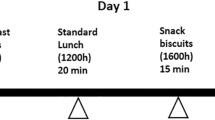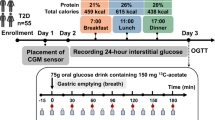Abstract
Background/objectives
The European Food Safety Authority approved a health claim (ID558) relating to lowered postprandial glycaemia when fructose replaces 30% of sucrose in foods and beverages. We assessed the effects of partial replacement of sucrose with fructose on serum glucose, uric acid and blood pressure.
Subjects/methods
A randomised, crossover, double blind trial of 12 normoglycaemic participants consuming beverages containing 50 g blends of fructose and sucrose in proportions; 67% sucrose/33% fructose (67%S:33%F); 50% each (50%S:50%F) and 33%S:67%F; a 100% sucrose reference beverage was tested twice. Serum glucose and uric acid concentrations were measured at 0, 15, 30, 45, 60, 90 and 120 min and incremental area-under-the-curve (iAUC) calculated.
Results
The geometric mean (95% CI) glycaemic iAUC following the 100% sucrose, 67%S:33%F, 50%S:50%F and 33%S:67%F blended beverages were 96 (63,145), 71 (46,109), 60 (39, 93) and 39 (12, 86) mmol/L min, respectively. At 33% fructose replacement, the proportionally lower iAUC of −28.5% (95% CI: −62.1, 5.2) mmol/L min was not different to sucrose alone. The response was lowered by fructose replacement of 50 and 67% and overall there was an inverse association (p < 0.001). The mean uricaemic iAUC to the respective beverages were 1320 (393, 2248), 3062 (1553, 4570), 3646 (2446, 4847), 3623 (2020, 5226) µmol/L min. Uric acid concentration was raised by all fructose-containing beverages with 33% fructose replacement causing an increase of 1741 (95% CI: 655, 2829) µmol/L min compared with sucrose alone. Blood pressure was not different among beverages.
Conclusions
Reduced postprandial glycaemia was achieved by the substitution of sucrose with fructose although elevated uricaemic responses should be cautioned.
This is a preview of subscription content, access via your institution
Access options
Subscribe to this journal
Receive 12 print issues and online access
$259.00 per year
only $21.58 per issue
Buy this article
- Purchase on Springer Link
- Instant access to full article PDF
Prices may be subject to local taxes which are calculated during checkout


Similar content being viewed by others
References
Thornley S, Tayler R, Sikaris K. Sugar restriction: the evidence for a drug‐free intervention to reduce cardiovascular disease risk. Intern Med J. 2012;42:46–58.
Lieberman M, Marks A, Peet A. Digestion, absorption, and transport of carbohydrates. Marks basic medical biochemistry: a clinical approach. 4th ed. Lippincott William and Williams; 2013. p. 493–511.
Tappy L, Egli L, Christel T. Metabolism of nutritive sweeteners in humans. In: Rippe JM (ed). Fructose, high fructose corn syrup, sucrose and health. Humana Press; 2014. p. 35–48.
Akgun S, Ertel N. A comparison of carbohydrate metabolism after sucrose, sorbitol, and fructose meals in normal and diabetic subjects. Diabetes Care. 1980;3:582–5.
Bantle J, Laine DC, Castle GW, Thomas JW, Hoogwerf BJ, Goetz FC. Postprandial glucose and insulin responses to meals containing different carbohydrates in normal and diabetic subjects. New Engl J Med. 1983;309:7–12.
Crapo PA, Kolterman OG, Olefsky JM. Effects of oral fructose in normal, diabetic, and impaired glucose tolerance subjects. Diabetes Care. 1980;3:575–81.
Foster-Powell K, Holt SHA, Brand-Miller JC. International table of glycemic index and glycemic load values: 2002 (Abstract). Am J Clin Nutr. 2002;76:5.
Gannon M, Nuttall F, Krezowski P, Billington C, Parker S. The serum insulin and plasma glucose responses to milk and fruit products in type 2 (non-insulin-dependent) diabetic patients. Diabetologia. 1986;29:784–91.
Jenkins DJA, Wolever TMS, Taylor RH, Barker H, Fielden H, Baldwin JM, et al. Glycemic index of foods: a physiological basis for carbohydrate exchange. Am J Clin Nutr. 1981;34:362–6.
ADA. Nutrition recommendations and interventions for diabetes. Diabetes Care. 2008;31:S61–78.
Brunzell J, Chiasson J, Garg A, La H, Hoogwerf B, Mayer-Davis E, et al. Evidence-based nutrition principles and recommendations for the treatment and prevention of diabetes and related complications. Diabetes Care. 2003;26:S51–61.
Livesey K, Taylor R. Fructose consumption and consequences for glycation, plasma triacylglycerol, and body weight: meta-analyses and meta-regression models of intervention studies. Am J Clin Nutr. 2008;88:1419.
United States Department of Agriculture. Sugar and sweeteners yearbook tables. Table 28. 2017. https://www.ers.usda.gov/data-products/sugar-and-sweeteners-yearbook-tables.aspx. Accessed 22 November 2017
Martillo MA, Nazzal L, Crittenden DB. The crystallization of monosodium urate. Curr Rheumatol Rep. 2014;16:400.
Choi HK, Mount DB, Reginato AM. Pathogenesis of gout. Ann Intern Med. 2005;143:499.
Emmerson BT. Effect of oral fructose on urate production. Ann Rheum Dis. 1974;33:276.
Stanhope KL, Schwarz JM, Keim NL, Griffen SC, Bremer AA, Graham JL, et al. Consuming fructose-sweetened, not glucose-sweetened, beverages increases visceral adiposity and lipids and decreases insulin sensitivity in overweight/obese humans. J Clin Investig. 2009;119:1322.
Bray GA. Fructose: pure, white, and deadly? Fructose, by any other name, is a health hazard. J Diabetes Sci Technol. 2010;4:1003–7.
Chiu S, JL S, De Souza R, Cozma A, A M, Carleton AJ, et al. Effect of fructose on markers of non-alcoholic fatty liver disease (NAFLD): a systematic review and meta-analysis of controlled feeding trials. Eur J Clin Nutr. 2014;68:416.
DiNicolantonio JJ, Amp Apos, Keefe JH, Lucan SC. Added fructose: a principal driver of type 2 diabetes mellitus and its consequences: a principal driver of type 2 diabetes mellitus and its consequences. Mayo Clin Proc. 2015;90:372–81.
Silbernagel G, Machann J, Unmuth S, Schick F, Stefan N, Häring HU, et al. Effects of 4-week very-high-fructose/glucose diets on insulin sensitivity, visceral fat and intrahepatic lipids: an exploratory trial. Br J Nutr. 2011;106:79–86.
Lustig R, Schmidt L, Brindis C. The toxic truth about sugar. Nature. 2012;482:27–9.
Agostoni C,BJ, Fairweather-Tait S. Scientific opinion on the substantiation of health claims related to fructose and reduction of post-prandial glycaemic responses (ID 558) pursuant to Article 13 (1) of Regulation (EC) no 1924/2006. EFSA J. 2011;9:2223–38.
Rho YH, Zhu Y, Choi HK. The epidemiology of uric acid and fructose. Semin Nephrol. 2011;31:410–9.
Johnson RJ, Segal MS, Sautin Y, Nakagawa T, Feig DI, Kang DH, et al. Potential role of sugar (fructose) in the epidemic of hypertension, obesity and the metabolic syndrome, diabetes, kidney disease, and cardiovascular disease. Am J Clin Nutr. 2007;86:899–906.
Ventura EE, Davis JN, Goran MI. Sugar content of popular sweetened beverages based on objective laboratory analysis: focus on fructose content. Obesity (Silver Spring). 2011;19:868–74.
Wolever TM, Jenkins DJ, Vuksan V, Jenkins AL, Wong GS, Josse RG. Beneficial effect of low-glycemic index diet in overweight NIDDM subjects. Diabetes Care. 1992;15:562–4.
Stanhope KL, Medici V, Bremer AA, Lee V, Lam HD, Nunez MV, et al. A dose-response study of consuming high-fructose corn syrup-sweetened beverages on lipid/lipoprotein risk factors for cardiovascular disease in young adults. Am J Clin Nutr. 2015;101:1144–54.
Alberti KG, Zimmet PZ. Definition, diagnosis and classification of diabetes mellitus and its complications. Part 1: Diagnosis and classification of diabetes mellitus provisional report of a WHO consultation. Diabet Med. 1998;15:539–53.
Handler J, Zhao Y, Egan BM. Impact of the number of blood pressure measurements on blood pressure classification in US adults: NHANES 1999-2008. J Clin Hypertens (Greenwich). 2012;14:751–9.
Williams SM, Venn BJ, Perry T, Brown R, Wallace A, Mann JI, et al. Another approach to estimating the reliability of glycaemic index. Br J Nutr. 2008;100:364–72.
Hirsch S, Barrera G, Leiva L, de la Maza MP, Bunout D. Variability of glycemic and insulin response to a standard meal, within and between healthy subjects. Nutr Hosp. 2013;28:541–4.
Brand J, Colagiuri S, Crossman S, Allen A, Roberts DC, Truswell AS. Low-glycemic index foods improve long-term glycemic control in NIDDM. Diabetes Care. 1991;14:95–101.
Giacco R, Parillo M, Rivellese A, Lasorella G. Long-term dietary treatment with increased amounts of fiber-rich low-glycemic index natural foods improves blood glucose control and reduces the number of hypoglycemic. Diabetes Care. 2000;23:1461–6.
Wolever TM, Mehling C, Chiasson JL, Josse RG, Leiter LA, Maheux P, et al. Low glycaemic index diet and disposition index in type 2 diabetes (the Canadian trial of carbohydrates in diabetes): a randomised controlled trial. Diabetologia. 2008;51:1607–15.
MacFarlane LA, Kim SC. Gout: a review of nonmodifiable and modifiable risk factors. Rheum Dis Clin North Am. 2014;40:581–604.
Bardin T, Richette P. Definition of hyperuricemia and gouty conditions. Curr Opin Rheumatol. 2014;26:186–91.
Brule D, Sarwar G, Savoie L. Changes in serum and urinary uric acid levels in normal human subjects fed purine-rich foods containing different amounts of adenine and hypoxanthine. J Am Coll Nutr. 1992;11:353–8.
Cox CL, Stanhope KL, Schwarz JM, Graham JL, Hatcher B, Griffen SC, et al. Consumption of fructose- but not glucose-sweetened beverages for 10 weeks increases circulating concentrations of uric acid, retinol binding protein-4, and gamma-glutamyl transferase activity in overweight/obese humans. Nutr Metab (Lond). 2012;9:68.
Bruun JM, Maersk M, Belza A, Astrup A, Richelsen B. Consumption of sucrose-sweetened soft drinks increases plasma levels of uric acid in overweight and obese subjects: a 6-month randomised controlled trial. Eur J Clin Nutr. 2015;69:949–53.
Sun SZ, Flickinger BD, Williamson-Hughes PS, Empie MW. Lack of association between dietary fructose and hyperuricemia risk in adults. Nutr Metab. 2010;7:16
Wang D, Sievenpiper J, de Souza R, Chiavaroli L, Ha V, Cozma A, et al. The rffects of fructose intake on serum uric acid vary among controlled dietary trials1-4. J Nutr. 2012;142:916–23.
Pan A, Hu FB. Effects of carbohydrates on satiety: differences between liquid and solid food. Curr Opin Clin Nutr Metab Care. 2011;14:385–90.
Stanhope KL. Sugar consumption, metabolic disease and obesity: the state of the controversy. Crit Rev Clin Lab Sci. 2016;53:52–67.
Brown C, Dulloo A, Yepuri G, Montani J-P. Fructose ingestion acutely elevates blood pressure in healthy young humans. Am J Physiol. 2008;294:R730.
Malik AH, Akram Y, Shetty S, Malik SS, Yanchou Njike V. Impact of sugar-sweetened beverages on blood pressure. Am J Cardiol. 2014;113:1574–80.
The European Food Information Council. Food-based dietary guidelines in Europe. http://www.eufic.org/en/healthy-living/article/food-based-dietary-guidelines-in-europe. Accessed 24 August 2017,
Sievenpiper JL. Fructose: back to the future? Am J Clin Nutr. 2017;106:439–42.
Tappy L, Le KA. Metabolic effects of fructose and the worldwide increase in obesity. Physiol Rev. 2010;90:23–46.
Jin M, Yang F, Yang I, Yin Y, Luo JJ, Wang H, et al. Uric acid, hyperuricemia and vascular diseases. Front Biosci (Landmark Ed). 2012;17:656–69.
El Ridi R, Tallima H. Physiological functions and pathogenic potential of uric acid: a review. J Adv Res. 2017;8:487–93.
Hu, FB. Resolved: there is sufficient scientific evidence that decreasing sugar‐sweetened beverage consumption will reduce the prevalence of obesity and obesity‐related diseases. Obes Res. 2013; 14: 606–19.
Acknowledgements
This study was registered with the Australian New Zealand Clinical Trials Registry (ANZCTR) reference ACTRN12616001502426.
Funding
The study was funded by the University of Otago.
Author information
Authors and Affiliations
Corresponding author
Ethics declarations
Conflict of interest
The authors declare that they have no conflict of interest.
Rights and permissions
About this article
Cite this article
Rodrigues, N., Peng, M., Oey, I. et al. Glycaemic, uricaemic and blood pressure response to beverages with partial fructose replacement of sucrose. Eur J Clin Nutr 72, 1717–1723 (2018). https://doi.org/10.1038/s41430-018-0134-x
Received:
Revised:
Accepted:
Published:
Issue Date:
DOI: https://doi.org/10.1038/s41430-018-0134-x
This article is cited by
-
Formulations of low-sugar strawberry jams: quality characterization and acute post-pandrial glycaemic response
Journal of Food Measurement and Characterization (2021)



